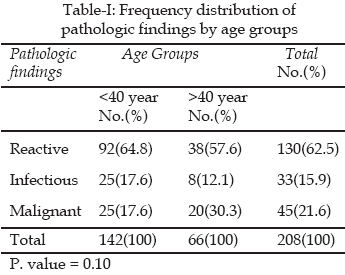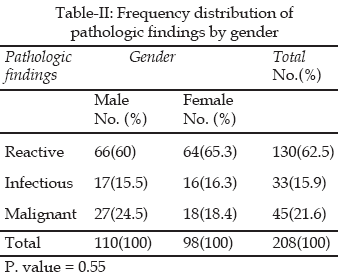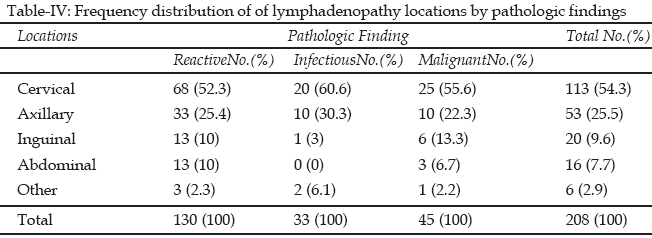|
 |
|
Published
by : PROFESSIONAL MEDICAL PUBLICATIONS |
|
ISSN 1681-715X |
|
|
|
- |
|
ORIGINAL
ARTICLE |
|
- |
|
Volume 25 |
October - December 2009
(Part-I) |
Number
5 |
|
|
|
Histopathologic findings of lymph node biopsy cases
in comparison with clinical features
Shokouh Taghipour Zahir1, Alireza Azimi2
ABSTRACT
Objective: To determine useful and important
clinical signs and symptoms for evaluation of lymphadenopathy with
consideration of histopathologic findings of biopsy.
Methodology: This retrospective case-series study
was done on patients hospital folders who came with lymphadenopathy,
Informations was collected about clinical signs, symptoms, age, gender and
histopathologic findings. It was then analyzed by SPSS version 13 with
chi-square test.
Results: There were 208 specimens, 98 women (47.1%)
and 110 men (52.9%). Mean age was 32.94 years. There were 45 cases (21.6%) of
malignancy, 33 cases (15.9%) of infectious diseases and 130 cases (62.5%) of
reactive lymphadenopathy. The most common histopathologic finding in all ages
was reactive lymphadenopathy. Clinical signs and symptoms had significant
relationship with pathologic findings.
Conclusion: For a decision of lymph node biopsy
attention to patients symptoms and signs especially B signs, size of the lymph
node >2cm, generalized lymphadenopathy, mobility of lymph node and
splenomegaly seems to be the useful guide lines for physician. In this study
it seems that decision to take biopsy was correct in 75% of the cases.
KEY WORDS: Lymphadenopathy, Biopsy, Malignancy.
Pak J Med Sci October - December 2009
(Part-I) Vol. 25 No. 5 728-733
How to cite this article:
Zahir ST, Azimi A. Histopathologic findings of lymph node biopsy cases in
comparison with clinical features. Pak J Med Sci 2009;25(5):728-733.
1. Shokouh Taghipour Zahir,
Assistant Professor of Surgical and
Clinical Pathology,
Department of Pathology,
2. Alireza Azimi
General Physician
1-2: Shahid Sadoughi University of
Medical Sciences & Health Services,
Yazd – Iran.
Correspondence:
Shokouh Taghipour Zahir, MD AP,CP
Assistant Professor of Surgical and
Clinical Pathology, Dept. of Pathology,
Shahid Sadoughi General Hospital,
Ebnecina BLV. Safaeyeh,
Yazd – Iran.
E-Mail: shokouh_zahir@yahoo.com
* Received for Publication: February 10, 2009
* Accepted: July 31, 2009
INTRODUCTION
Lymphadenopathy is defined as abnormal size or structure of
lymph node. It is a common problem in all age groups. It is mostly caused by
benign disorders and shows transient responses to the local or general
infections but sometimes it is due to malignant disorders.
1
We usually consider age, location of lymphadenopathy, duration of disease,
being local or generalized, other signs and symptoms like fever and
splenomegaly. According to the location of lymphadenopathy we can make some
differential diagnosis for example, cervical lymphadenopathy is usually due to
pharyngitis, otitis, dental abscess, measles, rubella, infectious
mononucleosis, CMV and other viral infections, Kikuchi disease, lymphomas and
metastatic carcinoma from pharynx.2,3
In supraclavicular lymphadenopathy we should think about
gastrointestinal cancers. Inguinal lymphadenopathy may indicate STDs (sexually
transmitted diseases) and cancers of genitalia or anal canal. Abdominal
lymphadenopathy is mostly due to malignancy and sometimes tuberculosis. There
are many etiologies for generalized lymphadenopathy. Some of them are: ALL,
CLL, Hodgkin’s lymphoma, non Hodgkin’s lymphoma, infectious mononucleosis, CMV,
AIDS, toxoplasmosis, tuberculosis, rheumatoid arthritis, lupus and
sarcoidosis.
2
Lymphadenopathy in children and young adults is usually due
to benign and reactive etiologies; in contrast, in ages older than 50,
prevalence of malignant etiologies increase.
3,5
In referral centers such as
hematology wards, prevalence of malignant lymphadenopathy in biopsy specimens
is about 40%.6
Generally in primary health care we can say that patients older than 40 years
with lymphadenopathy without obvious causes have the chance of malignancy
about 4% and in patients under age 40 years this chance is about 0.4%.7
In review studies done on patients with lymphadenopathy
there was 17.5% malignant etiology including, 11.4% lymphoproliferative
disorders and 6.1% metastasis, 31% had reactive benign etiologies and 26% had
other non malignant diseases.
8,9
In a study done by Nilgun Yaris et al. in 2006 on 126
lymphadenopathy cases, 98 patients had lymphadenopathy out of which 52% were
local and 48% were generalized. The most common area was neck. Seventy five
patients had benign etiologies, 60% of patients had reactive lymphadenopathy
and 39% had lymphadenitis and lymphadenitis in comparison with lymphadenopathy
was more local and had a larger size>3 cm. Twenty three patients had
malignancy and were older than other patients and enlargement of
supraclavicular nodes was mostly due to malignancy. The risk of malignancy was
higher in patients with generalized lymphadenopathy, lymph node larger than
3cm, hepatosplenomegaly and high serum level of LDH. This study determined
important clinical clues that can be useful in differential diagnosis of
lymphadenopathy.
1
In a study done by Memon W, Samad A et al. in Pakistan from
year 2002 to 2006 on 498 patients with cervical lymphadenopathy, 40 patient
(8%) had Hodgkin’s lymphoma, 80% of them were men and 20% were women. Most of
the patients were in stage 2 or 3 of disease. Patients clinical feature such
as "B" symptoms, anorexia and location of lymphadenopathy was determined.
Finally researchers showed that prevalence of Hodgkin’s lymphoma in cervical
lymphadenopathy in their country is less than western countries.
10
Study done by Burns B, et al. in 1985 on 69 patients with
lymphadenopathy the most common pattern of lymphadenopathy was reactive
follicular hyperplasia (62%), 8 patients had Hodgkin’s lymphoma and two
patients had non Hodgkin’s lymphoma.
11
Al Maghrabi J et al. study done
in 2005 on 2500 lymph node biopsy specimens, they found 15 cases with
Kikuchi-Fujimoto disease (0.6%), with F/M ratio = 2.7/1, mean age was 29 years
and most common location was cervical area.12
In yet another study made by Moor SW et al. in 2003 on 1877
cervical lymphadenopathy in cases younger than 15 years, 1.5% were normal,
48.7% had non specific reactive hyperplasia, 36.3% had chronic granulomatous
changes, tuberculosis lymphadenitis was seen in 25%. 2/3 of 154 patients with
neoplastic lymphadenopathy had lymphoma. In 32 cases pyogenic organisms were
found and 5 cases were HIV positive. This study showed that an important cause
of cervical lymphadenopathy in developing countries is tuberculosis and other
infections.
13
Another study done by Freidig EE et al. in 1986 on 419
lymph node biopsy specimens, in 113 cases the cause of lymphadenopathy was
unknown, 92 cases had sarcoidosis, 86 cases had lymphoma, 17 cases were
metastatic cancer, histoplasmosis was seen in 18 cases and tuberculosis in 13
cases. From 66 cases of infectious lymphadenopathy 48 cases had granulomatous
or acute inflammatory lesions.
14
Thus, physicians should consider level of referral and
conditions of patient and epidemiologic background of that area for better
approach to lymphadenopathy. Indications of lymph node biopsy is not so clear
and it depends on physician opinion and it should be performed considering all
patient conditions, clinical features and epidemiologic information about
different causes of lymphadenopathy. On the other hand, these type of studies
are rare in our country and we need more statistical informations about
prevalence of reactive, infectious and malignant causes of lymphadenopathy and
relationship between these causes and clinical signs and symptoms of patients,
so that we can make more reliable decisions about patients with
lymphadenopathy.
METHODOLOGY
This descriptive case-series study was done on patients
hospitalized in Yazd Shahid Sadoughi hospital from 21 March 2006 to 22 July
2008 and lymph node biopsy was performed for them. We had 208 cases and their
age ranged from 1 to 83 years. Those patients who were known cases of cancers
and were hospitalized for relapse of cancer and those cases with insufficient
information were excluded. Questionnaires were filled from reports of
pathology ward and patients hospital folders. These information included age,
gender, date of hospitalization, signs, symptoms and histopathology results of
biopsy.
Clinical signs and symptoms included in our study were:
cough, fever, night sweat, weight loss, pain and tenderness of lymph node,
anatomic site of lymphadenopathy, being localized or generalized, size of
lymphadenopathy, consistency, mobility of lymph node and presence of
splenomegaly. Finally information were analyzed by SPSS program (version13)
and Chi-square test. We consider the significant P. value < 0.05 was
considered significant.
RESULTS
We had 208 cases with age range 82 (from 1 to 83 years) and
mean age was 32.94 years with SD 19.08 years. There were 98 (47.1%) female and
110 (52.9%) male. One hundred thirty (62.5%) cases were reactive
lymphadenopathy, 33 (15.9%) cases were infectious and 45 (21.6%) cases had
malignancy. We had one case of angioimmunoblastic lymphadenopathy, three cases
of Castleman disease, four cases of Kikuchi- Fujimoto disease and 25 cases of
granulomatous lymphadenopathy. We divided the cases into two age groups: <15
years and >15 years. We divided them into two age groups: <40 years and
>40 years. The most common pathologic finding in all ages was reactive
lymphadenopathy, but in ages older than 40 years malignancy was in second
place. Pathologic findings had no significant statistic relationship with age
groups (P.value=0.051) (Table-I).

There was no significant relationship between gender and
pathologic findings (Table-II). The most frequent malignant lymphadenopathy
was Hodgkin’s lymphoma (44.4%) and the least was metastasis (22.2%).

Frequency distribution of clinical signs and symptoms had
significant relationship with pathologic findings. For example, fever, night
sweat and weight loss were seen mostly in malignancy and some infections and
none of malignant nodes had pain or tenderness. Size larger than 2cm and
generalized lymphadenopathy and splenomegaly was more common in malignancy.
(Table-III).

The most common location of lymphadenopathy was neck area
and in this location we had the most malignant cases. Axillary area was in
second place after neck and in third place was inguinal area (Table-IV).

There was no significant relationship between pathologic
findings and consistency of lymphadenopathy. (p.value = 0.08) most of
lymphadenopathies were firm and most of malignant nodes were also firm.
DISCUSSION
In this study we determined frequency distribution of
histopathologic findings of lymph node biopsies and relationship between these
findings and clinical signs and symptoms. There were 130 (62.5%) cases of
reactive lymphadenopathy, 33 (15.9%) cases of infectious lymphadenopathy and
45 (21.6%) of malignant lymphadenopathy, including 20 cases (9.6%) of
Hodgkin’s lymphoma, 15 cases(7.2%) of non Hodgkin’s lymphoma and 10 cases
(4.8%) of metastasis.
According to these results, frequency distribution of
pathologic findings had no significant relationship with patients age, may be
because of few malignant cases in our study, although we used two different
ways for dividing age groups. Similarly in the study by Memon W et al. there
was no relationship between pathologic findings and age.
10
In other studies ages older than 40 was one risk factor for
malignancy.
1-3
We also found no relationship between pathologic findings and gender as
reported, by Yaris N et al. In some studies this factor was not included in
criterions.1
We found significant relationship between cough and
pathologic findings. Cough was seen mostly in infections and malignancies. In
similar studies we couldn’t find any result about this factor effect.
About "B" symptoms including fever, night sweat and weight
loss, most of patients with malignancy had "B" symptoms that is significantly
higher than benign groups (P.value < 0.001). Thus our findings here are like
all other studies that introduce "B" symptoms as useful and important factor
in approach to lymphadenopathy.
2,3,6
In our study there was significant relationship between
pathologic findings and pain or tenderness of lymph node; none of the
malignant cases had pain or tenderness and we can say that presence of pain or
tenderness can predict infectious or less common reactive causes. However
sometimes because of fast enlargement of malignant lymph node or hemorrhage in
it’s necrotic center we may see pain or tenderness.
2,3
There was significant relationship between pathologic
findings and generalized lymphadenopathy. From total 17 cases of generalized
lymphadenopathy 9 cases (53%) had malignancy and this is similar to other
studies.
1,2,8
In many studies and text books we can see that generalized lymphadenopathy is
almost always due to important systemic diseases.3,6
We couldn’t find any significant relationship between
location of lymphadenopathy and pathologic findings because statistically the
results did not show it. Fifty five percent of all cases were cervical
lymphadenopathy. Also in Nilgun et al. study there was no significant
relationship between location of lymphadenopathy and pathologic findings.
1
On the other hand, many sources have revealed that lymphadenopathy in some
places like supraclavicular and abdominal has more risk of malignancy.2,3,6
In our study as well as according to some after studies
there is no clinically distinct difference between firm, elastic and hard
consistency and many young physicians can not distinguish between them. We
collect all of these three types of consistency as ‘firm’. There was no
significant relationship between consistency of lymph node and pathologic
findings. Many studies confirm that we can not approach to patient only by
consistency of lymphadenopathy.
2,6
and consistency of lymph node can not predict whether lymphadenopathy is
benign or malignant. There was significant relationship between pathologic
findings and size of lymphadenopathy. Most of malignant (80%) and infectious
(60%) nodes had diameter larger than 2cm and most of reactive nodes were
smaller than 2cm. In some studies, researchers used two diameters of lymph
node (area) and they said that significant size of lymph node is 2.25cm2
or more.2,3
It seems that using two diameters of lymph node is more reliable.
There was significant relationship between pathologic
findings and mobility of lymph nodes. Most of those lymph nodes that were not
mobile, were malignant. But many studies have showed that we can not trust on
mobility of lymphadenopathy to determine whether it is benign or malignant. On
the other hand, fixed lymph nodes that have adhesion to surrounding tissues
may be due to metastatic cancers and lymph nodes involving in lymphomas are
usually mobile.
3,8
In our study there was significant relationship between
splenomegaly and pathologic findings; among nine cases of splenomegaly, six
cases had malignancy. We can say splenomegaly with lymphadenopathy almost
always show systemic and important diseases (mostly malignancies and some
infections like infectious mononucleosis) and these results are confirmed by
many other studies.
2,6,8
CONCLUSIONS
According to our study, for evaluation of lymphadenopathy
we should consider important signs and symptoms like "B" symptoms, size >2cm,
generalized lymphadenopathy, fixed lymph node and splenomegaly. In our study,
from 208 cases, 52cases had no signs like fever, night sweat, weight loss,
splenomegaly and generalized lymphadenopathy and size of their lymphadenopathy
was equal or smaller than 2cm. Thus we can say that 75% of our cases really
needed surgical biopsy.
REFERENCES
1. Nilgun Y, Murat C, Emin S, Umit C. Analysis of children
with peripheral lymphadenopathy. Clin Pediatr 2006;45:544-540.
2. Habermann TM, Steensma DP. Lymphadenopathy. Mayo Clin
Proc 2000;75:723-732.
3. Henry PH, Longo D. Enlargement of lymph nodes and
spleen. In: Harrison’s Principles of internal medicine. (16th edition) Kasper
DL, Brounwald E, Fauci A, longo D, Jameson J. Pub: Mc. Graw-Hill 2005;343-346.
4. Lin HC, Su CY, Hang CC. Kikuchi disease: A review and
analysis of 61 cases. Otolaryngo Head Neck Surge 2003;128:650-653.
5. Lee Y, Terry R, Luke’s RJ. Lymph node biopsy for
diagnosis: A statistical study. J Surge Oncol 1980;14:3-60.
6. Ferrer R. Lymphadenopathy: Differential diagnosis and
evaluation. American academy of family physicians. 15/oct/1998.www.aafp.org/981015ap/ferrer.html
7. Moore SW, Schneider JW, Schaaf HS. Diagnostic aspects of
cervical lymphadenopathy in children in the developing world: a study of 1877
surgical specimens. Pediatr Surg Int 2003;19(4):240-244
8. Brown JR, Skarin T. Clinical mimics of lymphoma. The
Oncologist 2004;9(4):406-416.
9. Chau I, Kelleher MT, Cunningham D. Rapid access
multidisciplinary lymph node diagnostic clinic: analysis of 550 patients. Br J
Cancer 2003;88:354-36.
10. Memon W, Samad A, Sheikh GM. Hodgkin’s lymphoma in
cervical lymphadenopathy. Pak J Med Sci 2008;24(1):118-1211.
11. Burns BF, Wood GS, Dorfman RF. The varied
histopathology of lymphadenopathy in the homosexual male. Am J Surge Pathol
1985;9(4):287-297.
12. Al Maghrabi J, Kanaan H. Histiocytic necrotizing
lymphadenitis (Kikuchi-Fujimoto disease) in Saudi Arabia: clinicopathology and
immunohistochemistry. Ann Saudi Med 2005;25(4):319-323.
13. Fijten GH, Bligham GH. Unexplained lymphadenopathy in
family practice. An evaluation of the probability of malignant causes and the
effectiveness of physicians work up. J Fam Pract 1988;27:373-376.
14. Friedig EE, McClure SP, Wilson WR, Banks PM. Clinical – histologic-microbiologic
analysis of 419 lymph node biopsy specimens. Rev Infec Dis 1986;8(3):322-328.
HOME
| SEARCH
| CURRENT
ISSUE | PAST
ISSUES
Professional
Medical Publications
Room No. 522, 5th Floor, Panorama Centre
Building No. 2, P.O. Box 8766, Saddar, Karachi - Pakistan.
Phones : 5688791, 5689285 Fax : 5689860
pjms@pjms.com.pk




